Volvo 240 DL 1986, 240 GL 1986 Owner Manual

1986 Volvo 240
1 9 8 6 VOLVO
240 DL, 240 GL
Welcome to the world-wide family of Volvo owners. We trust that you will enjoy many years of safe driving in your Volvo, an automobile designed with your safety and comfort in mind. To ensure your satisfaction with this vehicle, we encourage you to familiarize yourself with the equipment descriptions, operating instructions, and maintenance requirements/recommendations in this manual. We also urge you and your passengers to wear seat belts at all times in this (or any other) automobile. And, of course, please do not operate a vehicle if you may be affected by alcohol, medication, or any impairment that could hinder your ability to drive.
Notice:
Your Volvo is designed to meet all applicable safety and emission standards, as evidenced by the certification labels attached to the door opening sheet metal and on the left wheel housing in the engine compartment. For further information regarding these regulations, please contact your dealer.
© 1985, VOLVO CARS OF NORTH AMERICA a Division of Volvo North America Corporation
 Contents
Contents
DESCRIPTION Page
General Information 2
Keys 3
Instruments and controls 4
Instruments 6
Warning lights 7
Ignition switch, turn signals 8
Lighting 9
Windshield wipers, washer nozzles 10
Washer fluid reservoir 11
Rear window demister, heated seat, hazard warningflasher 12
Parking brake 13
file:///K|/ownersdocs/1986/1986_240/86240_00.htm (1 of 5)12/30/2006 7:50:07 AM
1986 Volvo 240
Clock, ambient temperature gauge 14
Oil pressure gauge, voltmeter 15
Cigarette lighter, ash trays 16
Electrically operated windows 17
Heating and ventilation 18
Air conditioning 20
Radios, AM-FM-FM stereo/tape players 21
Front seats 22
Seat belts 24
Doors and locks 26
Rear doors, trunk lid, vent windows 27
Hood release, Long load storage 28
Rear/side view mirrors 29
Interior light, sun roof, fuel tank cap 30
Rear seat (wagon) 31
Tailgate (wagon) 32
Cargo compartment (wagon) 33
STARTING AND DRIVING
Service inspection 34
Break-in period 34
Driving economy, shift indicator light 35
Starting the engine 36
Manual transmission 37
Automatic transmission 38
Emergency towing 40
Towing information 41
Trailer hauling 42
Automatic transmission, brake system 43
Catalytic converter 44
MAINTENANCE SERVICE
Maintenance services 45
Service requirements 46
Engine B230F 48
file:///K|/ownersdocs/1986/1986_240/86240_00.htm (2 of 5)12/30/2006 7:50:07 AM

1986 Volvo 240
Engine oil, Oil/oil filter change interval 52
Fuel requirements 50
Engine fluids 51
Cooling system 53
Servicing 56
Transmission oil 60
Rear axle, power steering, brake fluid 62
Lubrication 63
Coolant 64
Alternator, jump starting 65
Replacing bulbs 66
Fuses 71
Wheels and tires 72
Wheel changing 74
Replacing wiper blades 76
Washing, cleaning 76
Cleaning, anti-rust treatment 77
Paint touch-up 78
Long distance trips, cold weather 81
Service diagnosis 82
Specifications 88
Volvo Service Manuals 94
Index 95
All information, illustrations and specifications contained in this manual are based on the latest product information available at the time of publication. Volvo reserves the right to make model changes at any time, or to change specifications or design, without notice and without incurring obligation.
 pg. 2 General Information
pg. 2 General Information
file:///K|/ownersdocs/1986/1986_240/86240_00.htm (3 of 5)12/30/2006 7:50:07 AM
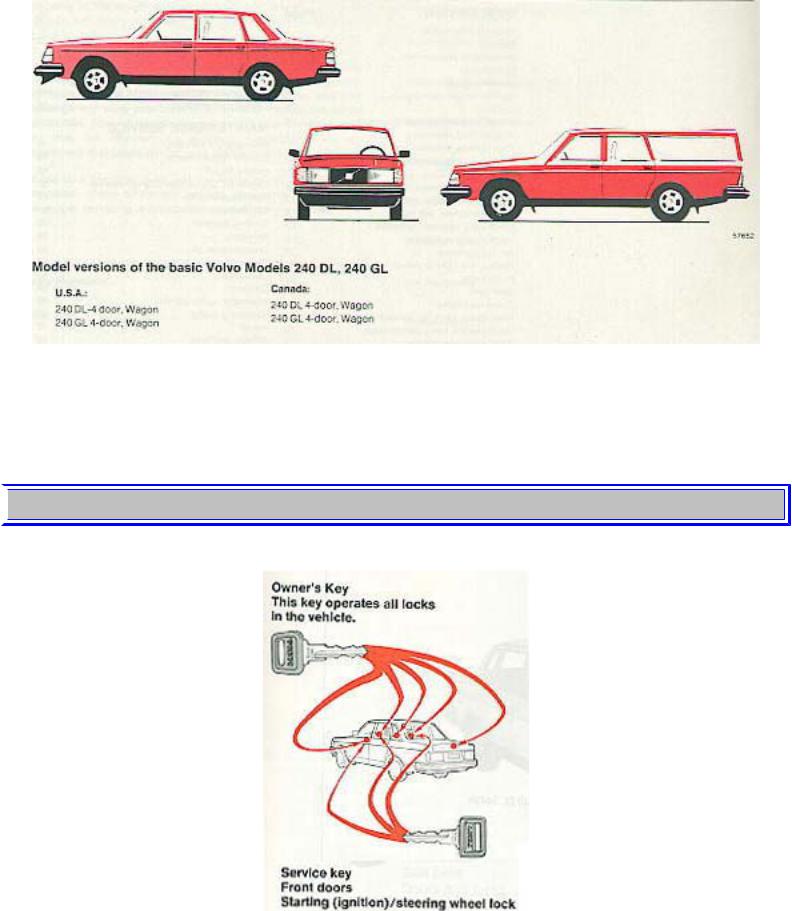
1986 Volvo 240
Do not export your Volvo to another country before investigating that country's applicable safety and exhaust emission requirements. In some cases it may be difficult or impossible to comply with these requirements. Modifications to the emission control system(s) may render your Volvo noncertifiable for legal operation in the U.S., Canada and other countries.
 pg. 3 Keys
pg. 3 Keys
The key number codes are stamped on a separate tag supplied with the keys. This tag should be
file:///K|/ownersdocs/1986/1986_240/86240_00.htm (4 of 5)12/30/2006 7:50:07 AM

1986 Volvo 240
separated from the key ring and kept in a safe place.
The double-sided tape on the back of the tag can be used to secure it safely.
In the event the original keys are lost, duplicates may be ordered from your Volvo dealer.
Top of Page
file:///K|/ownersdocs/1986/1986_240/86240_00.htm (5 of 5)12/30/2006 7:50:07 AM

1986 Volvo 240
1 9 8 6 VOLVO
240 DL, 240 GL
 pg. 4 Instruments and controls
pg. 4 Instruments and controls
 pg. 5 Instruments and controls
pg. 5 Instruments and controls
See page 1 Air louver 19
2 Turn signals 8
3 Headlights, parking lights 9
4 Instruments, lights 9
5 Instruments 6
file:///K|/ownersdocs/1986/1986_240/86240_01a.htm (1 of 20)12/30/2006 7:50:08 AM

1986 Volvo 240
6 Wiper/washer, tailgate window wiper/ washer (wagon) 10, 11
7 Starting (ignition) switch/steering wheel lock 8
8 Air louver 19
9 Storage compartment (extra instrument or radio location) -
10 Air louver 19
11 Glove box -
12 Air louver 19
13 Fuse box 65
14 Hood release handle 26
15 Horn -
16 Cigarette lighter 14
17 Rear window demister 12
18 Hazard warning flashers 12
19 Air conditioning 18
20 Seat belt reminder light 22
21 Heating and ventilation 16
22 Gear lever or gear selector 35, 36
23 Ash tray 16
24 Fresh air louver 19
25 Radio receptacle 21
26 Fresh air louver 19
27 Electrically-operated windows (240 GL) 17 28 Control for electrically operated side mirrors (certain models only) 29 29 Parking brake 13 30 Electrically-operated window, right front door (240 GL) 17
31 Seat belt release buttons 24
32 Seat heaters 13
33 Seat belt reminder light 24
34 Ash tray 16
The pages in this section provide a detailed description of the vehicle's instruments and controls.
Note that some vehicles may be equipped differently, depending on model, special legal requirements, etc.
 pg. 6 Instruments
pg. 6 Instruments
file:///K|/ownersdocs/1986/1986_240/86240_01a.htm (2 of 20)12/30/2006 7:50:08 AM
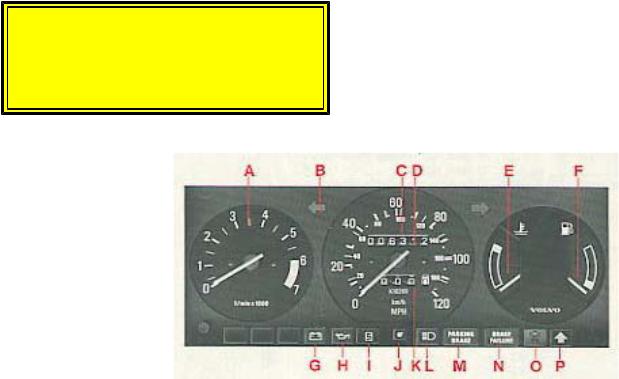
1986 Volvo 240
A Clock or Tachometer (depending on model)
Tachometer reads thousands of engine rpm. Black range for momentary use, during acceleration. Engine should not be operated in red range.
B Direction indicator (green)
C Speedometer
In kilometers and miles per hour (U.S. models) In kilometers per hour (Canadian models)
D Odometer
Total reading in miles (U.S. models)
Total reading in kilometers (Canadian models)
E Temperature gauge
The gauge pointer should remain inside the black range during normal operation.
If the pointer enters the red range repeatedly, check coolant level and fan belt tension. (See sections titled "Cooling system and coolant")
WARNING!
allow engine to cool before adding fluid.
F Fuel gauge
The fuel tank capacity is approx. 60 liters = 15.8 US gals. See "Fuel requirements".
G Alternator warning light (red)
H Oil pressure warning light (red)
file:///K|/ownersdocs/1986/1986_240/86240_01a.htm (3 of 20)12/30/2006 7:50:08 AM

1986 Volvo 240
I Oil pressure warning light (red)
Illuminated when overdrive is engaged. (manual transmission models)
J Trip odometer reset knob
Push in to reset
K Trip odometer
L High beam indicator (blue)
M Parking brake reminder light (red)
N Brake failure warning light (red)
O Bulb failure warning light
(yellow) (automatic transmission models)
P Overdrive OFF indicator light (yellow)
(automatic transmission models)
Shift indicator light (yellow)
(manual transmission models)
 pg. 7 Warning lights
pg. 7 Warning lights
The warning lights described on this page should never be on when driving
When the ignition is turned on, and before the engine starts, all of the warning lights should be on to test the function of the bulbs. Should a light not go off after the engine has started, the system indicated should be inspected. (However, the parking brake reminder light will not go off until the parking brake is fully released.)
G Alternator warning light (red)
If the light comes on while the engine is running, check the tension of the alternator drive belt as soon as possible. (See section titled "Cooling system".)
file:///K|/ownersdocs/1986/1986_240/86240_01a.htm (4 of 20)12/30/2006 7:50:08 AM

1986 Volvo 240
NOTE: This warning light is illuminated if the alternator is not charging. However, alternator, parking brake, brake failure, and bulb failure will be illuminated at the same time due to the design of the system.
 H Oil pressure warning light (red)
H Oil pressure warning light (red)
If the light comes on during driving, the oil pressure is too low. Stop the engine immediately and check the engine oil level. See section titled "Engine Oil".
After hard driving, the light will come on occasionally when the engine is idling. This is normal, provided it goes off when the engine speed is increased.
 M Parking brake reminder light (red)
M Parking brake reminder light (red)
This light will be on when the parking brake (hand brake) is applied. The parking brake lever is situated between the front seats.
 N Brake failure warning light (red)
N Brake failure warning light (red)
If the light comes on while driving and the brake pedal can be depressed further than normal, it is an indication that one of the brake circuits is not functioning. Stop immediately, open engine hood and check brake fluid level (see section "Brake fluid, power steering").
Reservoir empty: do NOT drive. Tow car to shop for check/repair of brake system. Reservoir not empty: proceed immediately and with caution to a Volvo dealer for an inspection of the brake system.
 O Bulb failure warning light (yellow)
O Bulb failure warning light (yellow)
The light will come on if any of the following bulbs are defective:
one of the lower beams one of the tail tights
one of the brake lights (when the brake pedal is depressed).
See section on "Replacing Bulbs".
 pg. 8 Starting (ignition) switch, Turn signals
pg. 8 Starting (ignition) switch, Turn signals
Starting (ignition) switch/steering wheel lock
file:///K|/ownersdocs/1986/1986_240/86240_01a.htm (5 of 20)12/30/2006 7:50:08 AM

1986 Volvo 240
The steering wheel lock may be under tension when the car is parked. Turn the steering wheel slightly to free the ignition key.
A chime will sound if the starting key is in the ignition lock and the front door on the driver's side is open. The chime will also sound if the headlights or parking lights are on when the door is open. The chime goes off when the front door is closed.
Turn signals
1 Signal lever engaged for normal turns.
Note: A defective turn signal bulb will cause turn signal indicator and remaining signal lights to flash more rapidly than normal.
2 Lane change position. In maneuvers such as lane changing, the driver can flash the turn signals by moving the turn signal lever to the first stop and holding it there. The lever will return to the neutral position when released.
file:///K|/ownersdocs/1986/1986_240/86240_01a.htm (6 of 20)12/30/2006 7:50:08 AM
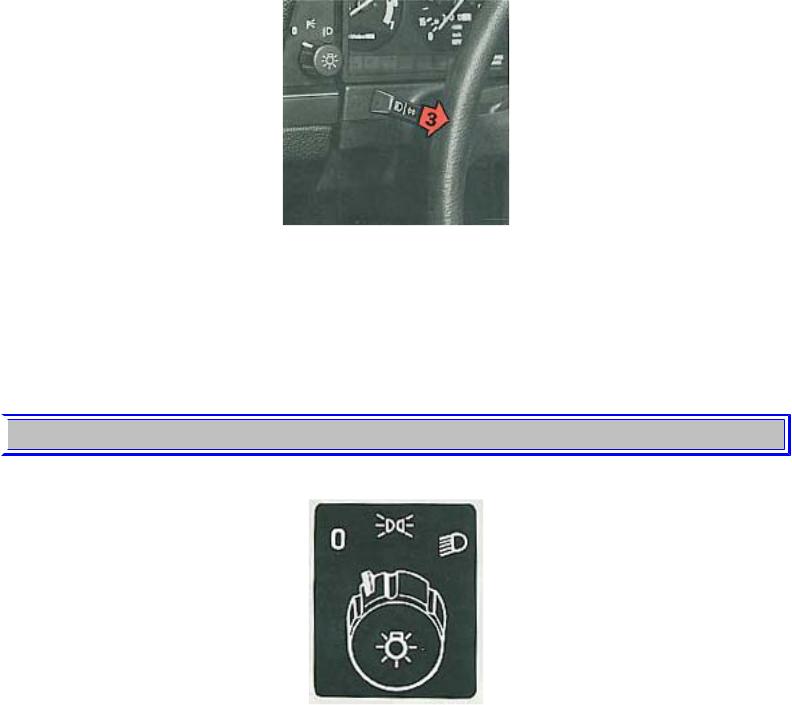
1986 Volvo 240
3 High and low beam switching (headlights on).
Move the lever towards the steering wheel and release it.
3 Headlight flasher (headlights off).
Move the lever towards the steering wheel. The headlight high beam will be on until the lever is released.
 pg. 9 Lighting
pg. 9 Lighting
Headlights and position lights
 All lights off
All lights off
 Parking lights on
Parking lights on
 Headlights and parking lights on
Headlights and parking lights on
Switch from upper to lower beams, and vice versa, by moving the turn signal switch lever on the left side of the steering column towards the steering wheel. The lights can be used without switching on the
file:///K|/ownersdocs/1986/1986_240/86240_01a.htm (7 of 20)12/30/2006 7:50:08 AM
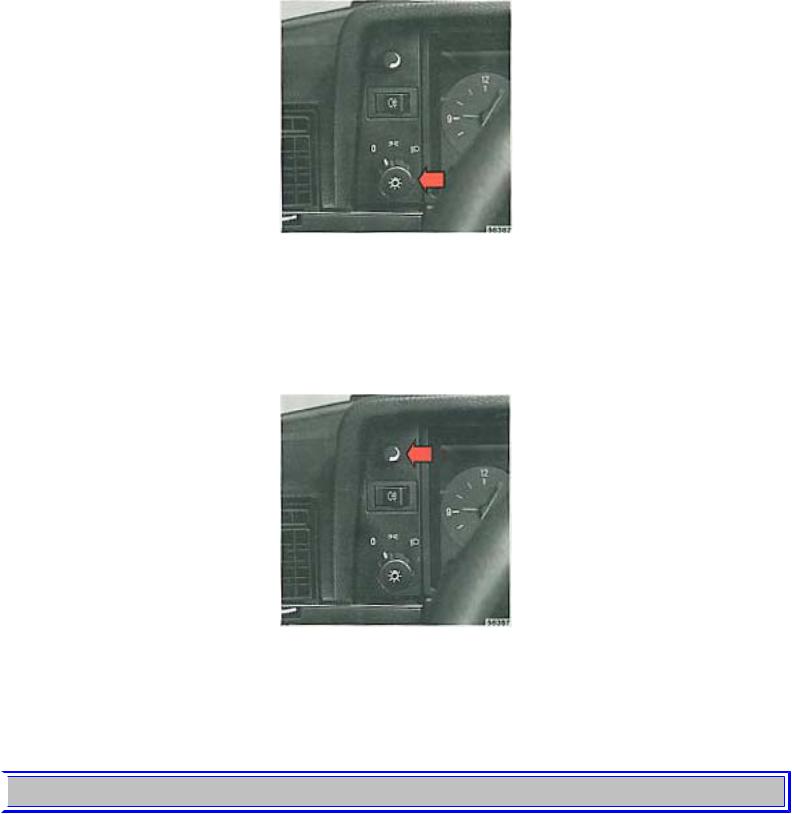
1986 Volvo 240
starting (ignition) key.
A chime will sound if the headlights or parking lights are on and the front door on the driver's side is open. The chime will also sound if the starting (ignition) key is in the switch lock when the door is open. The chime goes off when the driver's door is closed.
If the headlight is in position  , all lights will go out when starting (ignition) switch is switched off.
, all lights will go out when starting (ignition) switch is switched off.
Instrument panel lamps rheostat
Clockwise - brighter
Counterclockwise - dimmer.
 pg. 10 Windshield wipers, Tailgate window wiper, Washer nozzles
pg. 10 Windshield wipers, Tailgate window wiper, Washer nozzles
file:///K|/ownersdocs/1986/1986_240/86240_01a.htm (8 of 20)12/30/2006 7:50:08 AM

1986 Volvo 240
Wiper/washer
1 Intermittent wiper.
With switch in this position, the wipers will make a stroke approx. every seventh second.
2 "Single stroke" position.
Switch returns automatically when released.
3 Wipers, low speed.
4 Wipers, high speed.
5 Windshield wiper/washer.
The wiper will make 2-3 complete stroking cycles after the lever is released.
Tailgate window wiper/washer, wagon
Operated by the switch at the end of the windshield wiper/washer operating lever.
file:///K|/ownersdocs/1986/1986_240/86240_01a.htm (9 of 20)12/30/2006 7:50:08 AM
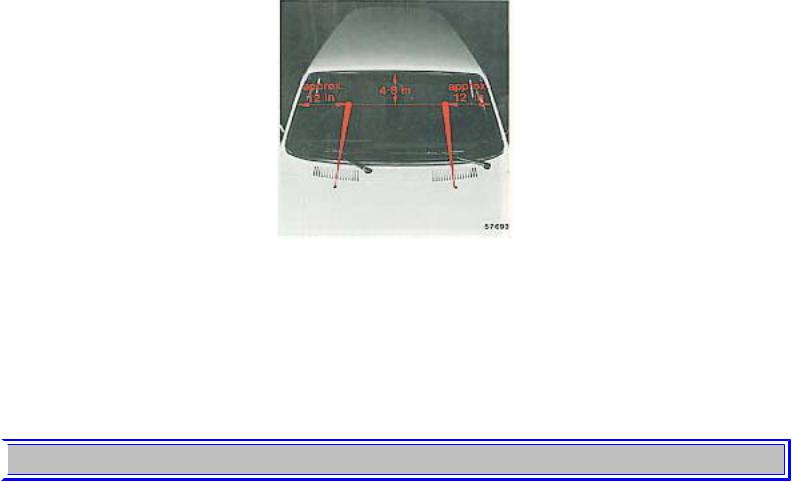
1986 Volvo 240
1 Tailgate wiper
2 Interval position
With the switch in this position, there is one stroking cycle approx. every fifteen seconds.
3 Tailgate washer
Depress the button to start the-wiper/washer. The wiper will complete 2-3 stroking cycles after the button is released.
Adjusting washer nozzles
The fluid spray may be adjusted by carefully inserting a needle into the metal nozzle and rotating nozzle to desired position.
4-8" = 10-20 cm. 12" = 30 cm.
 pg. 11 Washer fluid reservoir, Rear fog lights
pg. 11 Washer fluid reservoir, Rear fog lights
file:///K|/ownersdocs/1986/1986_240/86240_01a.htm (10 of 20)12/30/2006 7:50:08 AM
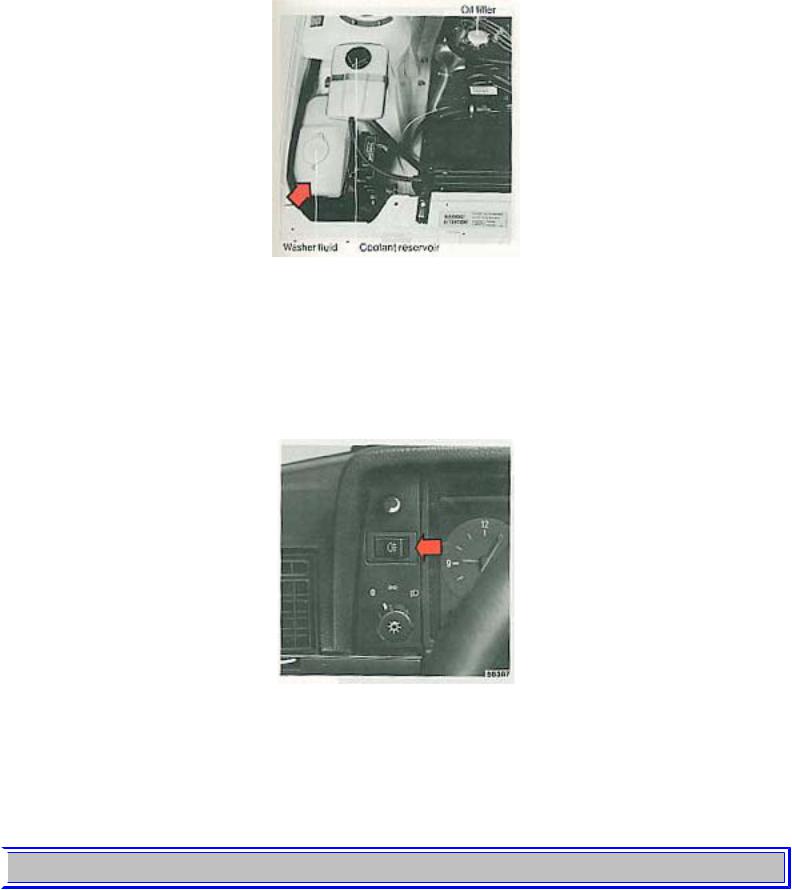
1986 Volvo 240
Washer fluid reservoir
The washer fluid reservoir for the windshield and tailgate washer (wagon) is located in the engine compartment and holds approx. 0.8 US gals = 3.2 liters.
During wintertime, the reservoir should be filled with anti-freeze washer fluid specified in section titled "Cold weather".
Rear fog lights
The rear fog lights are considerably brighter than the normal tail lights and should be used only when atmospheric conditions, such as fog, rain, snow, smoke or dust reduce the daytime or night time visibility of other vehicles to less than 500 ft. (152 meters). (The headlights must be switched on.) Note that local regulations governing the use of these lights may vary.
 pg. 12 Rear window demister, Hazard warning flasher
pg. 12 Rear window demister, Hazard warning flasher
file:///K|/ownersdocs/1986/1986_240/86240_01a.htm (11 of 20)12/30/2006 7:50:08 AM
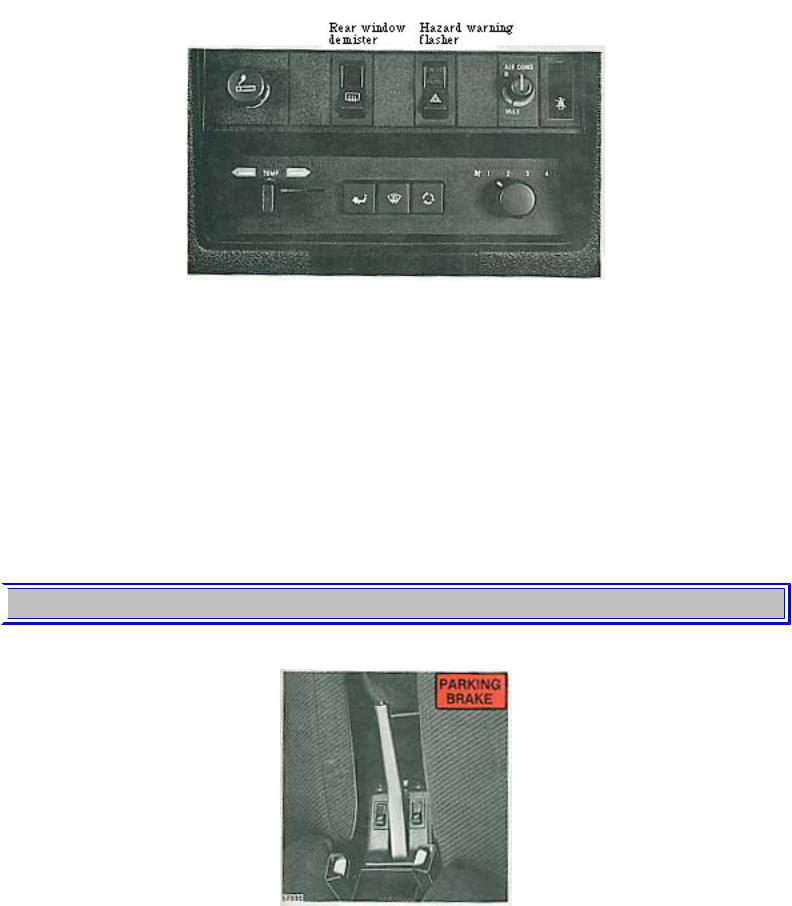
1986 Volvo 240
Rear window demister
To operate depress the switch. The indicator lamp in the switch will come on. The system will be switched off automatically after 10-15 minutes or when the starting (ignition) key is switched off. Do not place items against the inner surface of the rear window that may damage the printed circuit. Do not scrape the inner surface of the rear window glass with a hard object or use an abrasive window cleaner, otherwise damage to the printed circuit will occur.
Hazard warning flasher
The four-way flasher should be used to indicate that the vehicle has become a traffic hazard.
Note: Regulations regarding the use of the hazard warning flasher may vary from state to state.
 pg. 13 Parking brake
pg. 13 Parking brake
Parking brake (hand brake)
The lever is situated between the front seats. The brake is applied to the rear wheels.
file:///K|/ownersdocs/1986/1986_240/86240_01a.htm (12 of 20)12/30/2006 7:50:08 AM
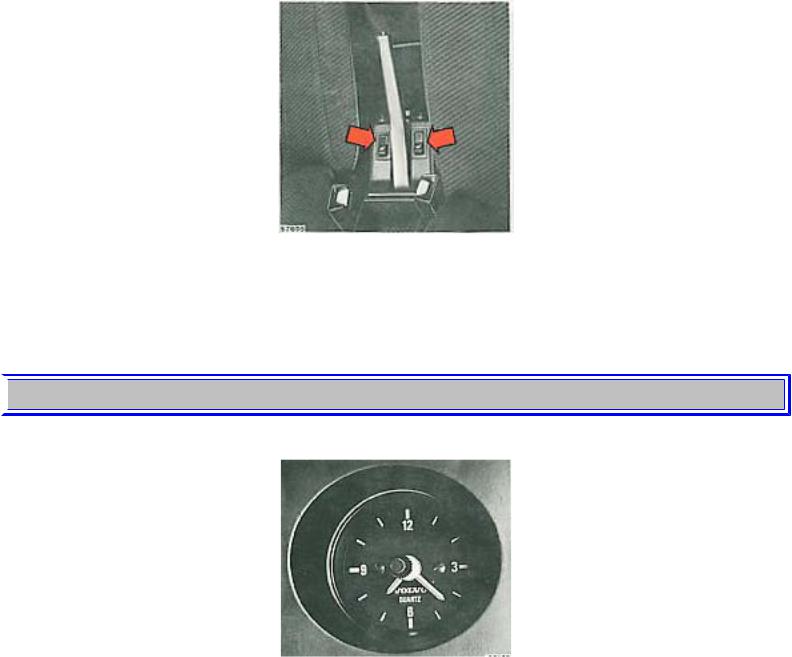
1986 Volvo 240
The PARKING BRAKE reminder light on the instrument panel comes on whenever the parking brake lever is not fully released and the ignition is on.
Always use the parking brake (hand brake) when parked.
In order to obtain the best possible performance of the parking brake, the brake linings should be broken in. (See section titled "Break-in period").
Seat heaters
The front seats are equipped with electrically-heated backrests and seat cushions. The switches engage the heating which then is thermostatically controlled. It switches on automatically when the temperature drops below 60°F (15°C) and switches off at approx. 95°F(35°C).
 pg. 14 Clock, Ambient temperature gauge
pg. 14 Clock, Ambient temperature gauge
Quartz crystal clock
To reset the hands, push in the reset knob and turn.
file:///K|/ownersdocs/1986/1986_240/86240_01a.htm (13 of 20)12/30/2006 7:50:08 AM
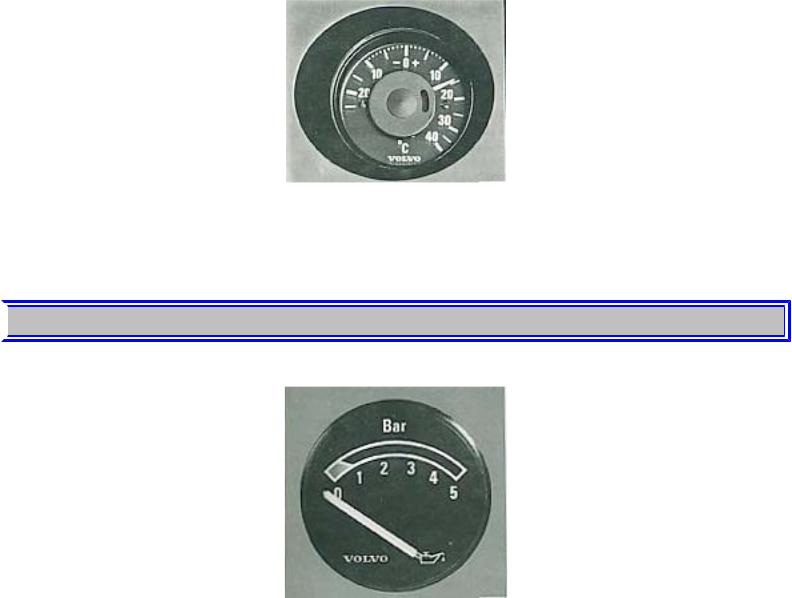
1986 Volvo 240
Ambient temp. gauge (accessory)
An electronic thermometer that indicates ambient temperature just above the road surface. Warns you of icy road conditions
 pg. 15 Oil pressure gauge, Voltmeter
pg. 15 Oil pressure gauge, Voltmeter
Oil pressure gauge (accessory)
The oil pressure gauge indicates the pressure of the oil in the lubricating system of the engine. The pressure is dependent on the speed of the engine, the oil temperature and the viscosity of the oil.
The gauge pointer must not go down to the red field while driving.
Note: While idling with a hot engine the pointer may go into the red field. This is not a cause for concern providing the pointer rises to the normal driving range again when you increase the engine speed.
file:///K|/ownersdocs/1986/1986_240/86240_01a.htm (14 of 20)12/30/2006 7:50:08 AM
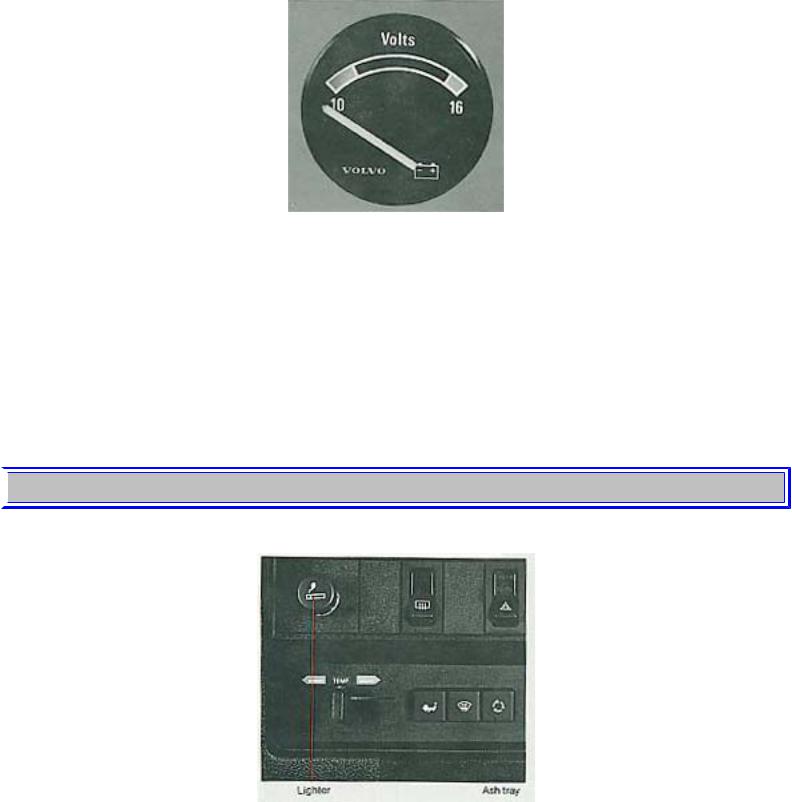
1986 Volvo 240
Voltmeter (accessory)
The voltmeter indicates the voltage in the electrical system and thereby also the state of the battery. While the car is being driven the pointer should be within the black field.
Should the pointer point to the upper or lower red field when driving, this may indicate some fault in the electrical system.
Note: While idling with a hot engine (especially with air conditioning ON), the pointer may indicate low voltage. This is not a cause for concern provided that the indicated voltage increases when you increase engine speed.
 pg. 16 Cigarette lighter, Ash trays
pg. 16 Cigarette lighter, Ash trays
Cigarette lighter
To operate, depress the knob fully. When the knob automatically releases, the cigarette lighter is ready for use.
The starting (ignition) switch must be ON for the cigarette lighter to function.
file:///K|/ownersdocs/1986/1986_240/86240_01a.htm (15 of 20)12/30/2006 7:50:08 AM
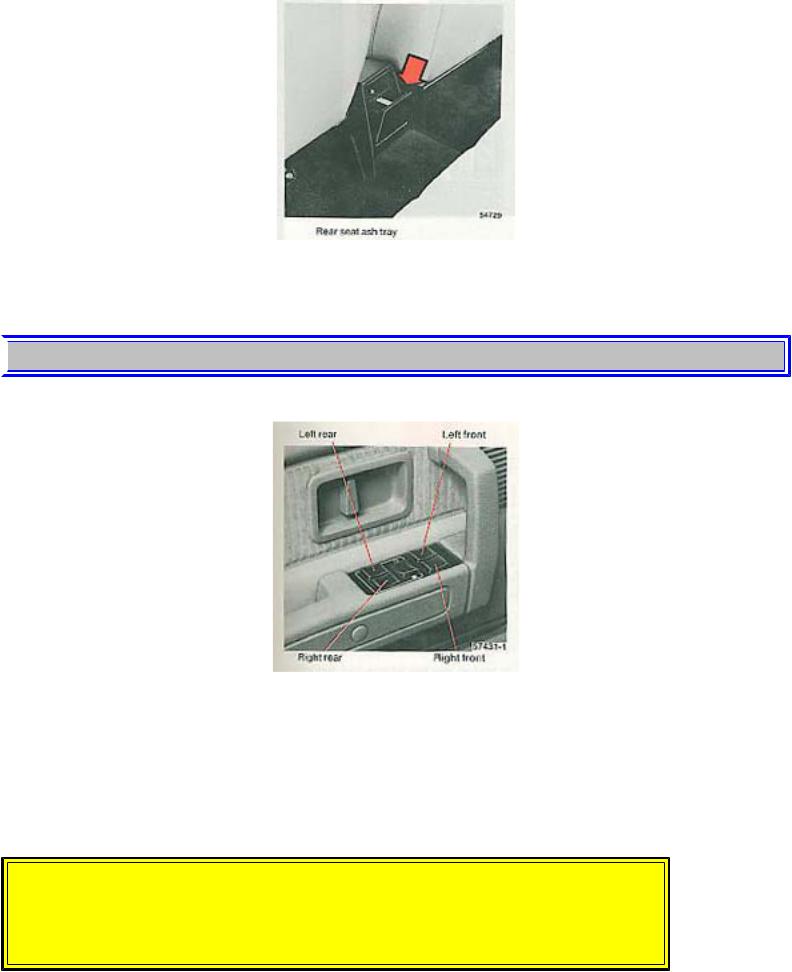
1986 Volvo 240
Ash trays
To remove the ash trays depress the center spring and remove.
 pg.17 Electrically-operated windows
pg.17 Electrically-operated windows
Electrically operated windows (standard on certain models)
The electrically-operated windows are controlled by switches set in the door arm rests. All the windows can be controlled from the driver's are rest as shown in the above illustration.
The starting (ignition) switch must be ON for the electrically-operated windows to function. The window is lowered if the rear part of the switch is pressed and raised if the front part of the switch is pressed.
WARNING!
Remove the starting (ignition) key from the car when children are left alone in the car.
file:///K|/ownersdocs/1986/1986_240/86240_01a.htm (16 of 20)12/30/2006 7:50:08 AM
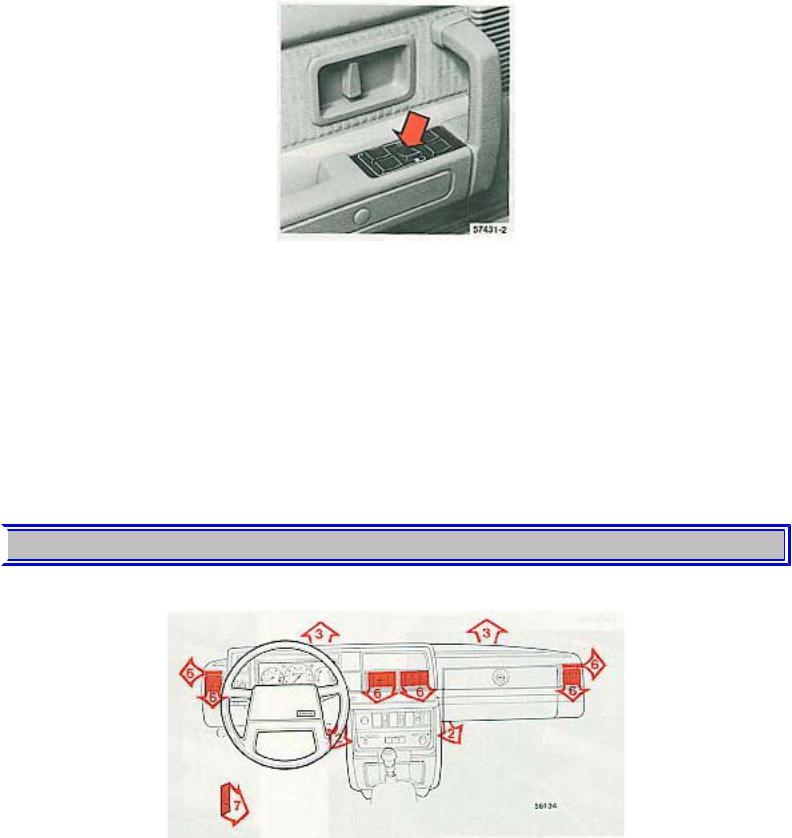
1986 Volvo 240
Cut-out switch for rear-door electrically-operated windows
If the car is equipped with rear-door power windows, this function can be disabled by a switch located on the driver's door armrest.
This switch is positioned 90° in relation to the other switches.
 The rear door windows can be raised or lowered with the respective door switch as well as the switch on the driver's door.
The rear door windows can be raised or lowered with the respective door switch as well as the switch on the driver's door.
 The rear door windows cannot be raised or lowered with the respective door switch but instead only with the corresponding switch on the driver's door.
The rear door windows cannot be raised or lowered with the respective door switch but instead only with the corresponding switch on the driver's door.
 pg. 18 Heating and ventilation
pg. 18 Heating and ventilation
Heating system
1 TEMP
file:///K|/ownersdocs/1986/1986_240/86240_01a.htm (17 of 20)12/30/2006 7:50:08 AM

1986 Volvo 240
Left = cool
Right = warm
2  FLOOR
FLOOR
Out = no air to floor
In = full flow of air to front and rear floor
3 Defrost
Defrost
Out = low volume air flow to defroster In = full flow
4 REC (recirculation)
REC (recirculation)
To be used only on cars equipped with air conditioning. Do not use for heating.
Out = full flow of outside air
In = air is recirculated for faster cooling
5  Blower motor
Blower motor
Has 4 speeds and is shut completely off when the knob is turned to the left.
6 Air louvers (dash)
The air flow through the louvers is decreased when the  (2) and/or
(2) and/or  (3) controls are depressed.
(3) controls are depressed.
7 Fresh air louvers (floor) (except models with air conditioning)
Lever placed forward = louver opens Lever placed rearward = louver closes
 pg. 19 Heating and ventilation
pg. 19 Heating and ventilation
How to . . .
. . . obtain max. heat
1 TEMP >>> WARM
file:///K|/ownersdocs/1986/1986_240/86240_01a.htm (18 of 20)12/30/2006 7:50:08 AM
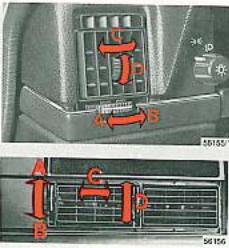
1986 Volvo 240
2  depressed
depressed
5 FAN  >>> 3(or 4)
>>> 3(or 4)
6 All dash louvers halfway open and floor air louver closed.
. . . remove condensation
1 TEMP >>>WARM
3 DEF  depressed
depressed
5 FAN  >>> 3 (or 4)
>>> 3 (or 4)
6 All louvers closed as well as the floor fresh air louver.
Always keep front external inlet grille (in front of the windshield) clear of obstructions (snow, ice, etc.).
Maximum defroster action
For maximum defroster capacity at very low ambient temperatures, use the recirculation control (button depressed).
If not using air conditioning, the recirculation feature should not be used in humid climates and at temperatures about +23°F (-5°C).
Air louvers - dash
AClosed
BOpen
CDirecting air flow horizontally
DDirecting air flow vertically
file:///K|/ownersdocs/1986/1986_240/86240_01a.htm (19 of 20)12/30/2006 7:50:08 AM
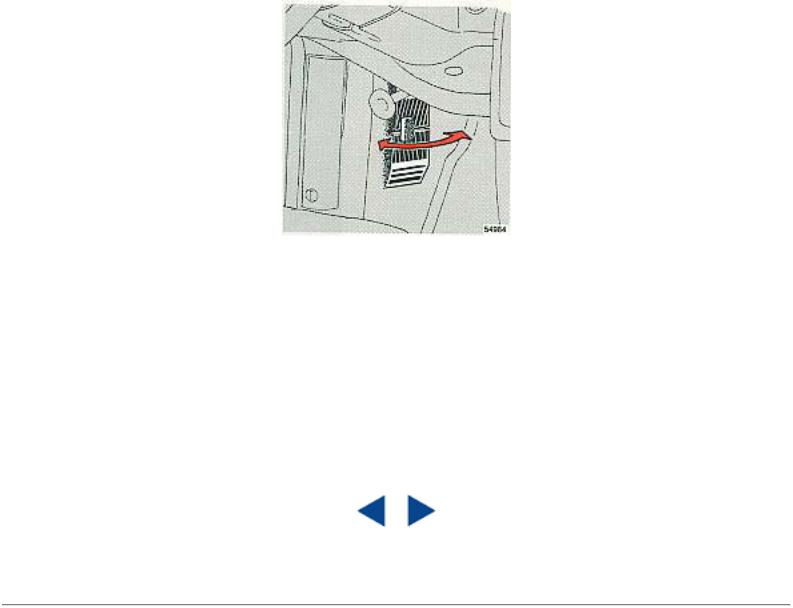
1986 Volvo 240
Fresh air louver (floor)
There is a floor-directed fresh air louver on the driver and passenger sides of the vehicle (driver's side only on some models). Airflow is controlled by the lever at the center of the louver.
Lever placed forward = louver opens
Lever placed rearward = louver closes
Maximum airflow is obtained with louver fully open and the fan (blower motor) shut completely off. (The fan forces the air through the dash louvers.)
Contents | Top of Page
file:///K|/ownersdocs/1986/1986_240/86240_01a.htm (20 of 20)12/30/2006 7:50:08 AM
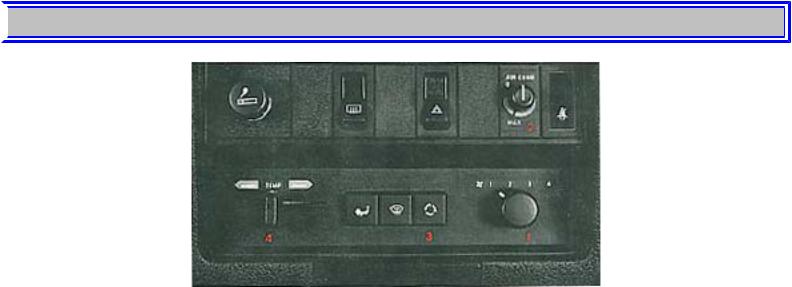
1986 Volvo 240
 pg. 20 Air conditioning
pg. 20 Air conditioning
Air conditioning (standard on certain models)
How to use the air conditioner:
1  Fan
Fan
Position 4 for rapid cooling.
2 AIR COND
Start the air conditioning compressor by turning the control knob clockwise toward MAX.
For rapid cooling, position the knob into the orange range beyond MAX. After desired temperature is reached re-position the control knob into the blue range.
At cruising speeds, the knob should be kept within the blue range. If it remains in the orange range, icing may occur resulting in decreased cooling capacity.
3  Recirculation
Recirculation
Push in for rapid cooling and during high humidity conditions.
4 TEMP
When using the air conditioner for cooling, the TEMP control should be set to COOL position, fully left. Use the AIR COND control to regulate the temperature.
To obtain rapid cooling, all windows must be closed and buttons  and
and  out. Close the floor fresh air louvers.
out. Close the floor fresh air louvers.
Cool air will then be discharged through the four dash outlets which should be fully open.
Note: For rapid removal of condensation from inside glass surfaces, the air conditioner can be switched on even when not required for interior cooling. The air conditioner will dehumidify the air inside the
file:///K|/ownersdocs/1986/1986_240/86240_01b.htm (1 of 18)12/30/2006 7:50:09 AM
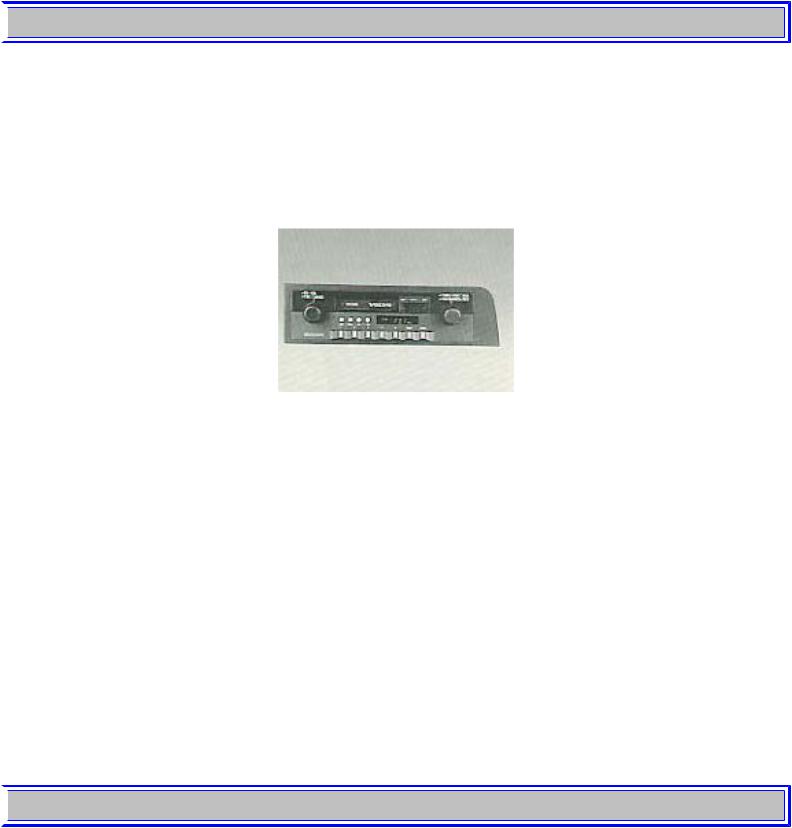
1986 Volvo 240
vehicle.
Have your Volvo dealer check the system for correct operation yearly. The air conditioning system should be operated periodically to ensure trouble-free performance year round.
 pg. 21 Radios, AM-FM-FM stereo/Tape players
pg. 21 Radios, AM-FM-FM stereo/Tape players
Operating instructions
The optional equipment is available from Volvo Accessories in several different models, each with its own special features. Operating instructions are contained in the manuals associated with each model. These manuals are placed in the cars when the equipment is installed by the Dealer.
Your Volvo Dealer will be able to assist you with any questions regarding the operation of this equipment.
Radio antenna mast
Note: Always lower the antenna mast when entering automatic car wash.
The following information may help to explain differences between car radio reception and radio reception in the home.
Signal sending
FM waves do not follow the earth's surface and do not bounce against the atmosphere as AM waves do.
Cross modulation
When receiving a weak signal in the vicinity of another, stronger signal, both stations may be received simultaneously.
Weak reception (fading)
Because of the limited range of FM senders and the way FM waves spread, this problem usually occurs with FM reception.
Mountains or similar obstacles can sometimes cause disturbances.
 pg. 22 Front seats
pg. 22 Front seats
file:///K|/ownersdocs/1986/1986_240/86240_01b.htm (2 of 18)12/30/2006 7:50:09 AM
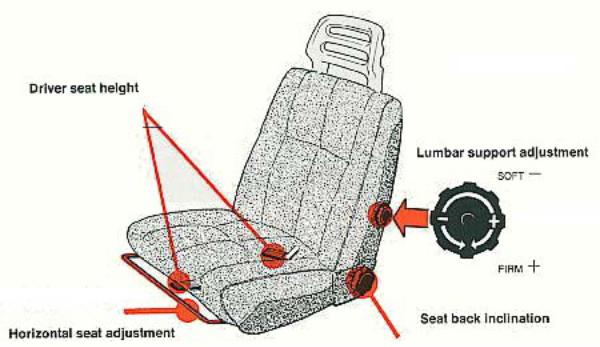
1986 Volvo 240
Driver seat height
There are two levers, each with three positions, for adjusting the height of the seat (front and/or back of cushion).
This allows adjustment of the seat cushion angle for added comfort. After adjusting the seat check that it is securely latched.
Note! Do not attempt to raise seat height while seated.
Horizontal seat adjustment
Pull control upward, then slide seat forward or rearward to desired position.
Make sure that the seat is properly secured when you release the control.
Note: For your safety, never adjust seat while driving.
Electrically heated front seats
The front seats are electrically heated and thermostatically controlled. The heater switches on automatically when the temperature drops below 60°F (15°C) and switches off at approx. 95°F (35°C). The heating may also be disengaged manually using the switches on the parking brake console.
Seat back inclination
Rotate control clockwise to tilt seat back rearward.
Rotate counterclockwise to tilt seat back forward.
Note that body weight must be shifted to allow seat back to move forward or rearward.
file:///K|/ownersdocs/1986/1986_240/86240_01b.htm (3 of 18)12/30/2006 7:50:09 AM
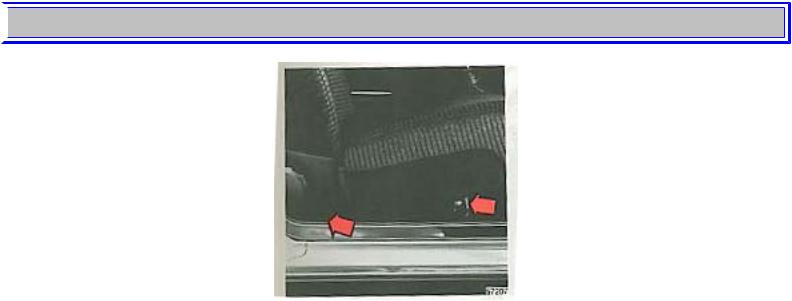
1986 Volvo 240
 pg. 23 Passenger seat, Child safety
pg. 23 Passenger seat, Child safety
Passenger seat height
The front passenger seat is retained by four brackets, each with three positions. The positions are the same as for the driver's seat. However, this adjustment must be accomplished manually, using appropriate hand tools.
Child safety
Volvo recommends the proper use of restraint systems for all occupants, including children. Remember that regardless of age and size, a child should always be properly restrained in a car.
Holding a child in your arms is NOT a suitable substitute for a child restraint system. In an accident, a child held in a person's arms can be crushed between the vehicle's interior and an unrestrained person. The child could also be injured by striking the interior, or by being ejected from the vehicle during a sudden maneuver or impact. The same can also happen if the infant or child rides unrestrained on the seat or in the cargo section of a station wagon. Other occupants should also be properly restrained to help reduce the chance of injuring or increasing the injury of a child.
In many states and provinces there is legislation governing how and where children should be carried in a car. Find out the regulations existing in your state or province.
A child restraint system can help protect a child in a vehicle. Here's what to look for when selecting a child restraint system:
●It should have a label certifying that it meets applicable Federal Motor Vehicle Safety Standards (FMVSS 213-80) - or in Canada, CMVSS 213.
●Make sure the child restraint system is appropriate for the child's height, weight and development - the label required by the standard or regulation, or instructions for infant restraints, typically provide this information.
●In using any child restraint system, we urge you to carefully look over the instructions that are provided with the restraint. Be sure you understand them and can use the device properly and safely in this vehicle.
●If your child restraint requires a top tether strap, consult your authorized Volvo dealer for top tether
file:///K|/ownersdocs/1986/1986_240/86240_01b.htm (4 of 18)12/30/2006 7:50:09 AM
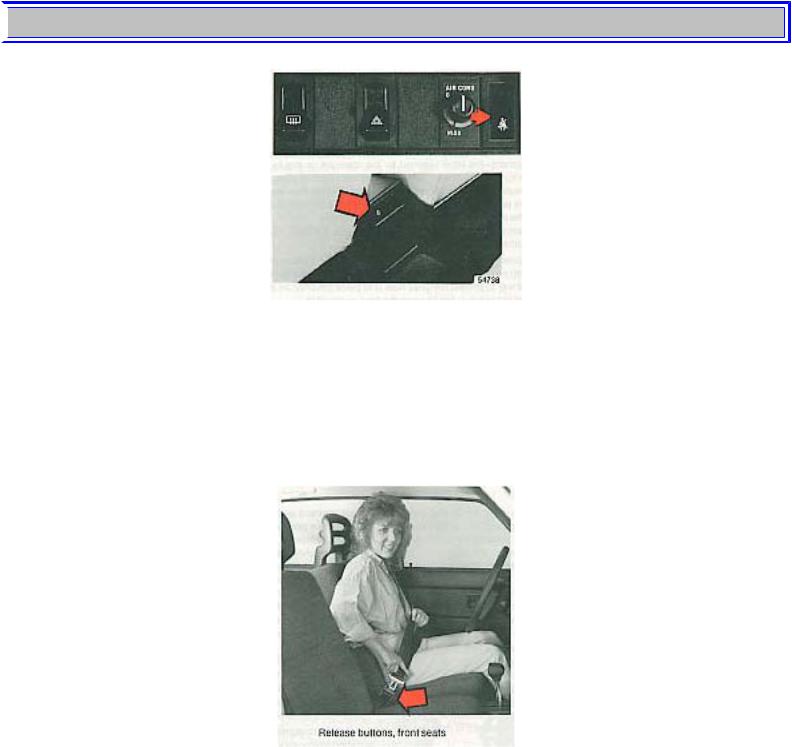
1986 Volvo 240
anchorage and installation information.
When a child has outgrown the child safety seat (approximately 4-5 years of age, depending on size) you should use the rear seat with the standard seat belt fastened. The best way to protect the child here is to place the child on a cushion so that the seat lap belt is as far down on the hips as possible.
A safety cushion for this purpose can be obtained from your Volvo dealer.
 pg. 24 Seat belts
pg. 24 Seat belts
Seat belts, retractable
Fasten the seat belts before you drive or ride.
Two lights will be illuminated for 4-8 seconds after the starting (ignition) key is turned to driving position. One light is located in the instrument cluster and one in the console between the front seats. A chime will sound at the same time if the driver has not fastened his seat belt. The front and rear outboard seats are provided with self-retracting inertia-reel belts.
To buckle:
file:///K|/ownersdocs/1986/1986_240/86240_01b.htm (5 of 18)12/30/2006 7:50:09 AM
